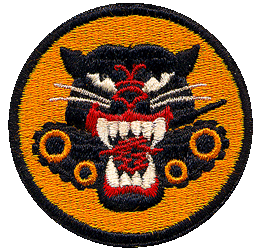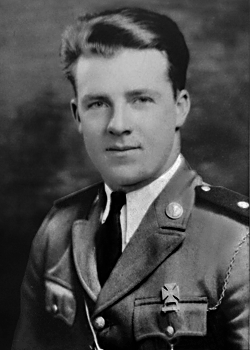 John S. Jarvie
John S. Jarvie
The following tribute was researched and written by Lowell Silverman. Lowell came across Lt. Jarvie while doing research on his grandfather, Dr. Robert Silverman, who served at the 32nd Station Hospital.
Biography: John Scott Jarvie was born on November 16, 1914 in Trenton Junction (now known as West Trenton), New Jersey. He was the sixth child of Albert and Daisy Jarvie and graduated from Bordentown Military Institute in 1936. In 1937, he married Bertha May Koller (1919–2003). The following years were apparently a difficult period in his life; despite his education, by April 1940, he had been unemployed for three years.
The photo at left is from Jarvie’s time at Bordentown.
On August 11, 1938, the Trenton Evening Times announced he was one of several men who “qualified for appointment as ambulance driver in the city employ” but he apparently wasn’t hired. The same paper announced on March 28, 1940, that Jarvie was one of 87 men who had passed an exam qualifying them to be hired by the Trenton Police Department, but the article also noted: “There are no vacancies at this time.” By 1942, however, Jarvie was working for the De Laval Steam Turbine Company in Trenton.
Service Time: Jarvie entered the U.S. Army on April 3, 1942. He was apparently commissioned as an Infantry 2nd lieutenant and was described as standing 5 feet, 8¾ inches tall and weighing 145 lbs when he entered the military.
Little is known about the early part of his service due to the loss of his records in the 1973 fire at the National Personnel Records Center. 2nd Lieutenant Jarvie was a member of the 894th Tank Destroyer Battalion at Fort Bragg, North Carolina by May 28, 1942. He went overseas to England in August 1942 and arrived in Oran, Algeria in January 1943 following the invasion of North Africa. Jarvie was promoted to 1st lieutenant effective January 14, 1943 (though the news didn’t catch up to him until March 23!) He was a member of Company “C”, 894th Tank Destroyer Battalion during the Tunisian campaign and fought at Kasserine Pass, El Guettar, and Bizerte.
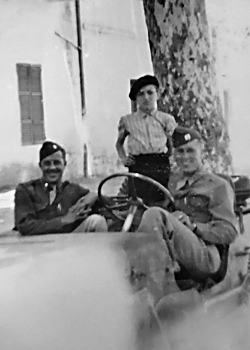
The photo at left shows Lt. Jarvie, left, with his company commander, Cpt. Baker D. Newton (1918–1961), and a civilian at center. The location is identified as Tlemcen, Algeria, in the summer of 1943.
At the end of May 1943, the 894th arrived at the Fifth Army Tank Destroyer Training Center near Sebdou, Algeria to begin the process of converting from M-3 to M-10 tank destroyers. Around this time, Lieutenant Jarvie befriended a nurse, 2nd Lieutenant Alice E. Griffin (1914–1963), who was a member of the 32nd Station Hospital in nearby Tlemcen. Jarvie was popular with the 32nd’s nurses and earned a reputation for his thoughtfulness. When off duty, he regularly stopped by the hospital with a jeep, often giving Griffin and her friends a ride to nearby towns or the Mediterranean Sea. Once, he even brought the hospital some gazelle meat after going hunting. As a result, when the 894th Tank Destroyer Battalion held a party at a villa in Tlemcen on September 30, 1943, Jarvie was put in charge of getting dates for 35 men—which, based on the T/O, would have been every officer in his battalion. He was successful in recruiting nurses for this mission, though he earned himself a lecture when he tried to persuade the 32nd Station Hospital’s commanding officer to let the nurses stay out after midnight! Griffin remarked in a letter to her family: “We got 35 nurses to go and that’s the largest [number] we’ve been able to get for anything – you might know J. did the asking.”
1st Lieutenant Jarvie Lieutenant was transferred out of Company “C” on September 13, 1943 and served a stint with the 894th’s HQ Company. He shipped out for Italy in October 1943. After a period on military police duty in Naples and some action in the Cassino area (primarily acting as self-propelled artillery), the 894th Tank Destroyer Battalion was deployed to the Anzio beachhead. Jarvie was involved in heavy fighting during the campaign. On February 3, 1944, he returned to Company “C” after one of its platoon leaders—2nd Lieutenant Wesley J. Schmidt (1918–1986)—was wounded.
Trenton Evening Times – February 28, 1944
At the tine Lieutenant Jarvie arrived back at the front lines, Companies “B” and “C” of the 894th Tank Destroyer Battalion were supporting the British 1st Infantry Division. That night, Jarvie’s M-10 tank destroyer and at least two others were caught behind enemy lines when the Germans attempted to wipe out the Campoleone salient. Contemporary news accounts differ slightly in the details, but at least one M-10 was commanded by Sergeant Leo E. Dobson (1914–1992). One of the articles, by Homer Bigart of the New York Herald Tribune, stated:
“Caught three miles inside the enemy lines soon after the enemy’s counter-attack began, they parked in the middle of a field and kept its approaches sprayed with machine gun fire. From midnight to dawn the 50 caliber machine gun mounted above the open hatch was busy. Lt. John S. Warvie, [sic] Trenton, NJ, relieved Dobson occasionally while other crew members slept.”
(Another article mentioned only that two tank destroyers escaped entrapment, Jarvie’s and one commanded by Lieutenant Herbert M. Siercks (1916–1986); it’s unclear if that means Siercks was in the third M-10 along with Jarvie and Dobson, or whether the article should have stated that two platoons under Siercks and Jarvie escaped from the Germans.)
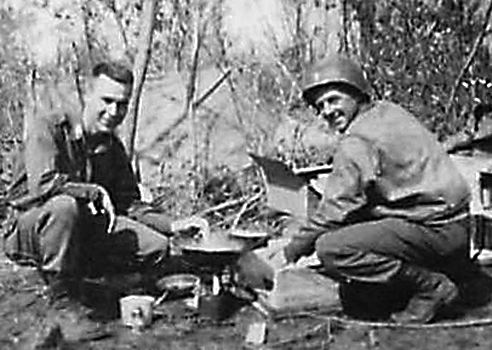
In this photo, Cpt. Newton is at left with Jarvie on the right. It looks like they may be preparing a meal. This photo was likely taken at Anzio in 1944.
In the morning (February 4), the tank destroyer crews destroyed several German machine gun positions before returning to friendly lines. The men of Company “C” established new positions closer to the base of the salient. That same day, Companies “B” and “C” were instrumental in defeating a German attack near Aprilia (“The Factory”). According to the S-3 (Operations and Training Officer) Periodic Report written by Captain Paul A. Baldy (1918–2008) covering the afternoon of Feb 3 through the afternoon of Feb 4, 1944:
“The enemy counterattacked very strongly during the period. ‘B’ & ‘C’ Companies participated very actively in repulsing the attack. ‘C’ Company destroyed four (4) Mark VI [Tiger] tanks. These have been confirmed by the British. One towed AT gun was destroyed while its crew was attempting to get it into firing position. Two destroyers held off the German infantry with their 50 cal. for two hours. Many casualties were inflicted. We lost two M 10’s–destroyed and one captured in this action. Two enemy occupied houses were also fired into by ‘C’ Company.”
Sergeant Dobson’s crew was credited with one of the Tigers. Lieutenant Jarvie may have been one of the men involved in holding off German infantry, as mentioned in Captain Baldy’s report; a February 6, 1944 article in the Trenton Sunday Times-Advertiser (based on an Associated Press report) stated that:
“Liaison officer between American tank destroyers and British infantry, Jarvie, at one critical moment when the tank destroyers were helping the British in the line, manned a .50-caliber antiaircraft gun on a tank destroyer […] and fired at the advancing rows of Germans. In order to get the proper angle he had to expose his body from the waist up so that he was vulnerable throughout the nearly half-hour of this kind of fighting, yet he was not even scratched.”
On May 26, 1944, during the breakout from Anzio, Company “C” of the 894th Tank Destroyer Battalion was assigned to support the 168th Infantry Regiment of the 34th Infantry Division during operations against the Caesar Line near Lanuvio, Italy. On May 28, 1st Battalion, 168th Infantry began a series of unsuccessful assaults on a German stronghold known as Villa Crocetta (located at approximately 41° 39′ 45” N, 12° 42′ 49” E along the present day Via di Colle Crocette, southeast of Lanuvio).
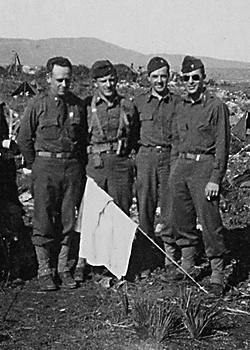 The photo at left shows Lts. Wright (Thomas), Uhler (Joseph R.), Jarvie and Newton in North Africa circa January 1943.
The photo at left shows Lts. Wright (Thomas), Uhler (Joseph R.), Jarvie and Newton in North Africa circa January 1943.
According to the History of the 168th Infantry Regiment for May 1944, by the afternoon of May 29, 1944, the men of 1st Battalion were close to exhaustion. They were ordered to make a fourth attack on the Villa. Unlike the previous three attacks, this one was made with the “support of four M-10 tank destroyers and three light tanks” including 1st Lieutenants Jarvie (and possibly Lieutenant Siercks). Jarvie’s crew consisted of Sergeant Robert D. Lightsey (gunner), Corporal Elmer F. Park (loader), Corporal John F. Perkins (driver) and Private Reamer H. Conner (assistant driver).
Accounts of the battle are contradictory, and the exact sequence of events difficult to put together from existing sources, but the situation was chaotic. According to the 168th Regimental history, “After the failure of the third attack on the Villa, [1st Battalion’s] Company ‘A’ and Company ‘C’ were approaching the point of complete demoralization” and most of them refused to advance; only Company “B” made any significant headway against the objective.
In a statement reproduced in Lieutenant Jarvie’s Individual Deceased Personnel File (I.D.P.F), Private Reamer H. Conner—assistant driver on Lieutenant Jarvie’s M-10—wrote that they had been attacking German infantry when they were notified of an imminent friendly artillery strike; they withdrew and replenished their ammunition supplies. Afterward, Conner continued, “We moved up again and we were crossing a ditch and threw a track. We finally got the track on with a bar, Sergeant Lightsey put a new antenna on (broken one was shot off).” The 168th Infantry history stated that “Three tank destroyers and two tanks reached the objective, where they split into two groups and advanced up each side of the hill, clearing houses as they went.”
At some point, Lieutenant Siercks’s M-10 was disabled by an enemy anti-tank gun, though he was credited with returning fire and destroying the gun. (Available documentation isn’t clear whether this event occurred during the assault on Villa Crocetta or a different operation nearby, on the same day.) According to Seek, Strike, Destroy: The History of the 894th Tank Destroyer Battalion in World War II by Patrick J. Chase (apparently based on accounts from veterans of the unit), three M-10s were knocked out by German fire, leaving only Jarvie’s. An account by 1st Lieutenant Francis W. Chandler (identified as an eyewitness in a press release by the War Department Bureau of Public Relations, though several aspects of his statement are of dubious accuracy) agreed that Jarvie’s M-10 was “the only remaining tank destroyer of a platoon that had made the initial assaults with the battalion.” The 894th Tank Destroyer Battalion’s total losses that day are uncertain, since the unit’s records from May and June 1944 went missing shortly after the war.
The 1st Battalion, 168th Infantry S-3 (Operations Officer), Captain William W. Galt, attempted to take charge of attack, which had reportedly stalled by this point. He boarded Lieutenant Jarvie’s M-10 and ordered it to spearhead the advance. Captain Galt manned the M-10’s .50 caliber machine gun during the renewed attack. Lieutenant Chandler stated that the M-10 was fired upon by an anti-tank gun but Jarvie’s crew successfully knocked it out, ostensibly after “Captain Galt directed fire on the gun”.
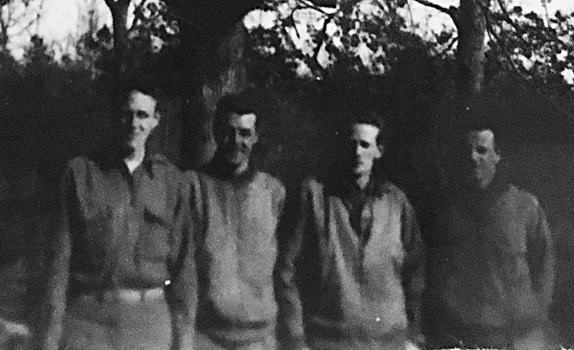
The photo above is identified as being taken at Anzio, Italy, and includes L to R, Mac (probably John W. McLoughlin), Jarvie, Herbert E. Burnham, and Uhler. McLoughlin was the battalion surgeon and Burnham was the battalion dental officer.
Private Conner recalled that Jarvie’s M-10 advanced through an olive grove and, spotting German soldiers, they “cleaned up the Infantry”. By all accounts, the Germans took heavy casualties, reportedly with 40 of them killed by Captain Galt’s fire alone. However, by the recollection of the M-10’s driver, Corporal Perkins, they hadn’t traveled very far when disaster struck. According to the 168th Infantry history, the 1st Battalion’s Intelligence Officer observed:
“an estimated company of Germans, supported by four tanks, counter-attacking down the valley with bayonets fixed. One of the tanks pulled up behind the Villa and fired a shell through the turret of a tank destroyer, killing the battalion operations officer who had been firing the tank destroyer’s 50 caliber machine gun at the retreating Germans.”
1st Lieutenant Raymond L. Wilson, Headquarters Company, 894th Tank Destroyer Battalion, wrote that he was told later that Jarvie’s “M-10 received a direct hit from a German tank at 40 or 50 yards distance”. Other accounts describe the M-10 as having been hit by enemy artillery, possibly an 88 mm shell.
In a statement reproduced in Lieutenant Jarvie’s I.D.P.F., Corporal Perkins recalled that:
“after we picked up this Infantry Captain, we traveled about one hundred (100) yards before we were hit. The Captain was standing on the back of the Tank Destroyer when he got killed. He was firing the .50 caliber. We were sitting still when the tank [sic] was hit. The shell came through the turret. I saw Lt. Jarvie and Sergeant Lightsey fall to the bottom of the turret. In about four or five seconds, the tank caught fire and I went out the turret on the left side after crawling over them (both of them). I’m certain that they were both dead.”
Private Conner recalled that he was initially unaware that the M-10 had been hit:
“I thought it was a .50 caliber shooting in our turret at first. As the hot lead sprayed around, Corporal Perkins shouted that he was hit and told us to get out. I jumped out when it blazed on the Ass’t. drivers side. I went out the turret and started running. Perkins stopped me and put the fire out in my hair. Then we crept, crawled, and ran to get into a ditch. Then we crawled over a small hill to where the Infantry was in a wheat field and then to the next wadi where the medic was. I don’t remember feeling anything. I had my eyes closed because it was blazing there and I didn’t want them burnt.”
 It’s not clear if the same German shell claimed the life of Corporal Park (whose body was located next to the burned out M-10), but Corporal Perkins (1908–1984) and Private Conner (1923-1998) were the only survivors of the crew. The 168th Infantry regiment history ruefully noted that the German “counter-attack, supported by tanks, was too strong for the twenty men left to hold the hill.” Perkins, Conner, and the surviving American infantry retreated. Captain Galt was subsequently awarded the Medal of Honor.
It’s not clear if the same German shell claimed the life of Corporal Park (whose body was located next to the burned out M-10), but Corporal Perkins (1908–1984) and Private Conner (1923-1998) were the only survivors of the crew. The 168th Infantry regiment history ruefully noted that the German “counter-attack, supported by tanks, was too strong for the twenty men left to hold the hill.” Perkins, Conner, and the surviving American infantry retreated. Captain Galt was subsequently awarded the Medal of Honor.
1st Lieutenant Jarvie and Sergeant Lightsey’s remains were originally buried together in Nettuno, Italy. After identification, they were subsequently reburied at Arlington National Cemetery (Section 34, Grave 4845) on January 17, 1950.
Trenton Evening Times Article – January 19, 1950
One detail not mentioned in Corporal Perkins’s statement was the fact that, as he escaped the burning tank destroyer, he grabbed an identification bracelet that Lieutenant Jarvie was wearing. Although he told his family that he had hoped to return the bracelet to Jarvie’s family, he was unable to do so during his lifetime. In 2008, April Anderson Padgett—the wife of Corporal Perkins’s grandson, began an effort to locate Jarvie’s family. She began telephoning people in the Trenton area with the last name of Jarvie but did not reach anyone from the right family. In May 2015, she made a post on Facebook with a photograph of the bracelet. She encouraged others to share it, and eventually over 2,000 people did. Although the process took more than a year, the post finally reached one of Lieutenant Jarvie’s great-nephews in July 2016. He contacted her and arranged for the bracelet’s return to the family.
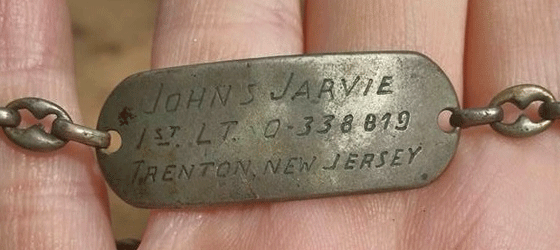
A special thank you to the Joseph R. Uhler and Baker D. Newton families for the use of their family photos and to Find A Grave contributer, Hope, for the use of the grave marker photo. You can read more about John S. Jarvie and the 32nd Station Hospital at Lowell’s website found here.
